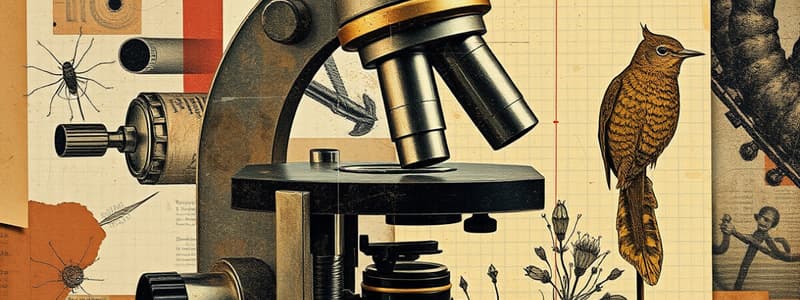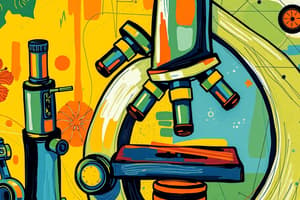Podcast
Questions and Answers
What is the function of the ocular lenses?
What is the function of the ocular lenses?
- To hold the slides in place
- To focus the image
- To adjust the light intensity
- To magnify the object being viewed (correct)
What does the rotating nosepiece do?
What does the rotating nosepiece do?
- Focuses the image
- Holds the ocular lenses
- Holds and rotates the objective lenses (correct)
- Controls the light source
What is the purpose of the objective lenses?
What is the purpose of the objective lenses?
- To magnify the image of the specimen (correct)
- To light the slide
- To adjust focus
- To hold the microscope in place
What is the stage in a microscope?
What is the stage in a microscope?
What is the mechanical stage?
What is the mechanical stage?
What is the function of the iris diaphragm lever?
What is the function of the iris diaphragm lever?
What does the condenser do?
What does the condenser do?
What is the purpose of the substage light?
What is the purpose of the substage light?
What is the arm of a microscope?
What is the arm of a microscope?
What does the power light control do?
What does the power light control do?
What is the course adjustment knob?
What is the course adjustment knob?
What is the fine adjustment knob?
What is the fine adjustment knob?
What is the base of a microscope?
What is the base of a microscope?
Flashcards are hidden until you start studying
Study Notes
Ocular Lenses
- Located at the top of the microscope, closest to the eyes.
- Typically have a magnification power of 10x.
- Help in viewing the specimen by focusing light.
Rotating Nosepiece
- A circular device that holds multiple objective lenses.
- Allows for quick switching between different magnifications.
- Enhances ease of use when examining various specimens.
Objective Lenses
- Primary lenses that provide different levels of magnification (e.g., 4x, 10x, 40x, 100x).
- Positioned directly above the specimen on the stage.
- Often par-focal, meaning they stay in focus when switching lenses.
Stage
- A flat platform where the microscope slide is placed for observation.
- Equipped with clips to secure the slide in position.
- Often has a graduated mechanism for precise positioning of the slide.
Mechanical Stage
- A type of stage that allows for precise movement of the slide using knobs.
- Facilitates easier view of the specimen without manual adjustments.
- Enhances the accuracy in locating specific areas of interest on the slide.
Iris Diaphragm Lever
- Controls the amount of light entering the condenser.
- Adjusts the contrast and resolution of the specimen image.
- Plays a critical role in viewing different types of specimens effectively.
Condenser
- Focuses light onto the specimen for enhanced clarity.
- Positioned under the stage, it collects and concentrates light rays.
- Essential for improving image quality and contrast.
Substage Light
- Illuminates the specimen from below, improving visibility.
- Provides consistent light for clear observation.
- Can be adjusted for intensity to suit different specimens.
Arm
- Supports the body tube and connects it to the base.
- Provides stability and structure for the microscope.
- Often includes carrying handles for safe transport of the microscope.
Power Light Control
- Regulates the brightness of the substage light.
- Allows users to adjust light intensity based on specimen characteristics.
- Enhances comfort and clarity during observation by minimizing glare.
Course Adjustment Knob
- Used for quick, large-scale focusing of the microscope.
- Typically located on the side of the arm.
- Important during initial focusing to place an object into view.
Fine Adjustment Knob
- Allows for precise focusing once the course focus is set.
- Ideal for obtaining sharp details in the specimen.
- Essential when using high-power objective lenses to avoid damage.
Base
- The bottom part of the microscope that provides stability.
- Contains the light source and may have built-in power controls.
- Serves as a foundation for all components of the microscope.
Studying That Suits You
Use AI to generate personalized quizzes and flashcards to suit your learning preferences.




